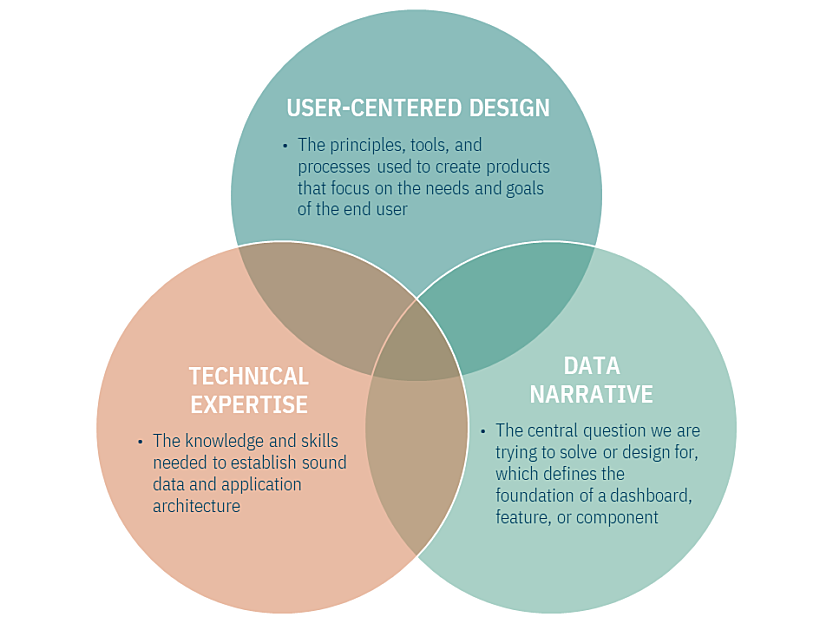At Education Analytics, we work closely with our partners to develop analytical dashboards that help transform their data from numbers into actionable guidance. There are many steps needed to translate raw data into an easy-to-understand, intuitive interface that is meaningful to a user audience. From visual design to the selection of a modern technology stack and the development build process, we aim to deeply understand and fulfill our partners’ needs through iterative collaboration and feedback. In this post, we will explore each of the central elements involved in the design and development of dashboards at EA—user-centered design, technical expertise, and an informed data narrative—followed by a case study of how we applied these principles to develop the “Focus on Students” feature in our latest Rally Analytics Platform application release.
User-Centered Design Principles
During the first phase of co-creating a dashboard, we work closely with stakeholders and end users to define the primary question(s) they seek to answer. There are myriad ways to display the same data, but it is important that the end user of the application has a voice in expressing how those data will be most useful to them. We collect this information through a series of user interviews: typically, hour-long sessions where our team asks a series of guided questions that allow each person being interviewed to convey what questions, and potential solutions, will add meaning to the dashboard from their perspective. The interviewer then reviews the information collected from the interviews with a team of collaborators representing each of the three central elements.
Next, the process moves into low-fidelity design iterations that include both conceptual frameworks (to outline how pieces fit together) and visual prototypes (to mock up what the visualizations will look like). It's imperative that design iterations center the data narrative, as the hierarchy of the application and data interpretation overlap in meaningful ways. As the application architecture and design begin to coalesce, higher fidelity visual mockups are produced and shared with partners for feedback. It is also at this stage that technical implementation teams (engineers and developers) are included, so they can begin to brainstorm data structures, development architecture, feasibility of implementation given any time or resource constraints, and what technologies are best suited for this specific application. The collection of feedback from both internal and external perspectives is incorporated into the final design, which results in high-fidelity mockups for development by the technical teams.
Technical Expertise
Technical implementation teams need to successfully collaborate with our education agency partners to create dashboards that support their needs. To do this, we need to leverage each team’s expertise to focus on the intersection of technical feedback, iteration, and implementation as it relates to user-centered design. Technology influences both the data and application architecture, and technological choices can impose limits on design. Understanding and communicating these dependencies is integral for design collaborators and partners.
During the development of analytical dashboards, technical teams will assess the priorities established for the specific application and determine the best path for development. For instance, some dashboards need to accommodate many users (>10,000), rely on large and complex data, have high performance and accessibility demands, or need to be distributed across a large geographical region (requiring more distributed computing power). Other dashboards have fewer users, involve smaller data sets, and need only be co-located to a smaller geographical region. Both time and budget constraints also help determine the best way to meet partner needs. While this is only a subset of considerations, most applications fall somewhere on this spectrum of size and performance. This is important, as these factors determine development build processes, application architecture, and feasibility of implementation. Considering these priorities when iterating with design collaborators is a central step to creating a dashboard that is holistically aligned with user needs—but it doesn’t end there. We also need to revisit the data narrative driving the creation of the dashboard.
Data Narrative
The data narrative defines the foundation of a dashboard, feature, or component; it is the central question we are trying to solve or design for. When first approaching a new dashboard build, we ask ourselves and our partners, “What is the vision or purpose that will guide the philosophy of this dashboard, feature, or component? What audience do we aim to better support by creating this tool?” If we have data available to us before we embark on the user-centered design process, we ask, “How can these data support better, more equitable outcomes?” The evolving answers to these questions throughout the development process aid us in laying the groundwork for a tool that can do more than simply find a usable solution to a problem.
Case Study: Focus on Students
The Rally Analytics Platform is a data-driven dashboard developed in partnership with the South Carolina Department of Education and California’s CORE Districts, with support from the Bill & Melinda Gates Foundation and the Michael & Susan Dell Foundation. The dashboard has a large of number of users with differentiated levels of access, including district-level users, school-level users, and teachers. The data underlying the dashboard are large and complex, have high performance and accessibility demands, and are distributed across the United States.
In the latest feature release, the Rally product team prioritized releasing new features to district- and school-level leaders that would allow them to quickly identify patterns and trends across their respective district or school. One such feature is called “Focus on Students.” The guiding question that drove the development of the Focus on Students feature through the lens of a district or school leader was, “How can I quickly identify students across my district (or in my school) that are most in need of support?”
The creation of Focus on Students was a synthesis of user-centered design, technical expertise, and an informed data narrative. The user-centered design process began with user interviews where we gathered perspective and knowledge from key district and school stakeholders in both South Carolina and California. Once we obtained a clear understanding of the user’s questions and needs, we centered the data narrative around the quick identification of students most in need across districts and schools for quick intervention in ELA, Math, and Well-being. This helped drive the design and incorporation of a “tiered metric,” which we describe more below.
Next, the design team began to iterate on multiple approaches to organize the data both conceptually and visually in a way that would make Focus on Students accessible and easy to use. We worked with both partners and key stakeholders (i.e., end users) throughout this iteration process, moving from low-fidelity prototypes to high-fidelity mockups ready for development. Before the high-fidelity mockup was complete, members of the engineering and development teams gathered feedback on the feasibility and complexities of developing Focus on Students as recommended by the design team. We incorporated adjustments to the design based on the input from each team, to ensure that the feature was fully functional from each angle of the system.
The screenshot below (which displays mock data for demonstration purposes) shows what the Focus on Students feature looks like in the Rally application. As noted above, our design process led to the addition of a tiered metric that summarizes student achievement and progress by categorizing students into one of three tiers. This new metric allows users to identify, using state-defined benchmarks, students most in need according to (1) different measures, (2) in a particular grade, (3) for a given season. For instance, a user can search for students who need support as measured by (1) Math Achievement Tier, (2) who are currently in grade 7 (3) as of Fall 20-21. This search yields 70 students in our hypothetical “EA District” in grade 7 who are categorized as either Tier 2 (Moderate Need) or Tier 3 (High Need) for Math Achievement. Below this result, there is a student dropdown, which shows a table containing students by school (in this instance, only one school: “EA Middle”) who meet the selection criteria, alongside other relevant information that could potentially help a district or school leader place the requested information into a more holistic picture of that student’s performance and well-being.
What We Learned
Throughout the development of Focus on Students, the Rally team came to a better understanding of how user-centered design, technical expertise, and an informed data narrative coalesce to support the final product. The successful intersection of these three elements also strengthened cross-team collaboration, communication, and understanding. Many teams and many dependencies exist throughout the creation of data-driven dashboards, and learning to manage those complexities has empowered EA to carry over lessons we’ve learned through reflection and experience as added value to our partners.
Focus on Students is now available in the Rally application for district and school leaders to quickly identify students most in need across their district or school. To see the Focus on Students feature in action, click on the button below.

